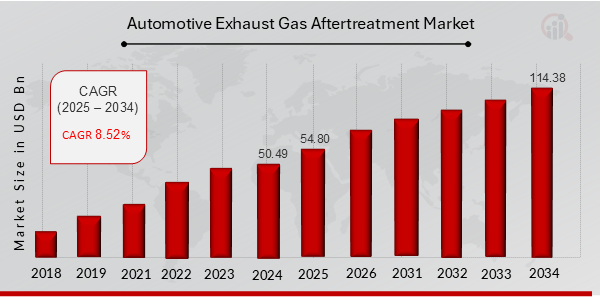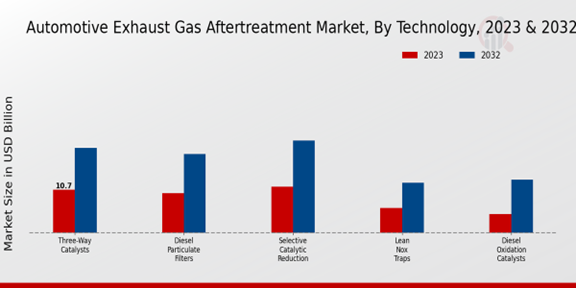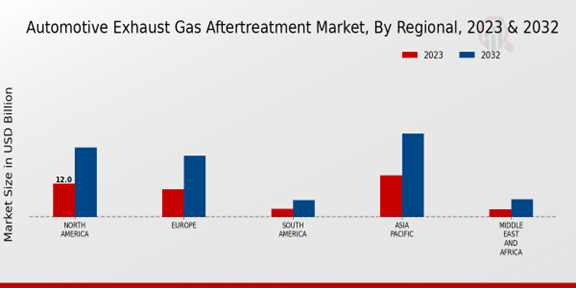Global Automotive Exhaust Gas Aftertreatment Market Overview:
As per MRFR analysis, the Automotive Exhaust Gas Aftertreatment Market Size was estimated at 50.49 (USD Billion) in 2024. The Automotive Exhaust Gas Aftertreatment Market Industry is expected to grow from 54.80 (USD Billion) in 2025 to 114.38 (USD Billion) till 2034, at a CAGR (growth rate) is expected to be around 8.52% during the forecast period (2025 - 2034).
Key Automotive Exhaust Gas Aftertreatment Market Trends Highlighted
The growing environmental concerns and stringent emission regulations worldwide are driving the automotive exhaust gas after-treatment market. Governments are implementing stricter emissions standards to reduce air pollution and promote sustainable transportation. This has led to increased adoption of exhaust gas after-treatment systems in vehicles.
Key market drivers include rising awareness about the adverse effects of vehicle emissions, technological advancements in emission control systems, and government incentives for eco-friendly vehicles. Emerging economies in Asia-Pacific and Latin America are expected to offer significant opportunities for market growth due to increasing vehicle production and urbanization.
Recent trends in the market include the development of advanced after-treatment technologies such as selective catalytic reduction (SCR) and diesel particulate filters (DPFs), which provide higher emission reduction efficiency. Additionally, increasing investment in research and development is leading to the introduction of lightweight and compact after-treatment systems, as well as systems that can handle higher exhaust temperatures.

Source: Primary Research, Secondary Research, Market Research Future Database and Analyst Review
Automotive Exhaust Gas Aftertreatment Market Drivers
Increasing Stringency of Emission Regulations
Governments worldwide are implementing increasingly stringent emission regulations to reduce air pollution and protect public health. These regulations are driving the demand for advanced automotive exhaust gas aftertreatment systems, as they can effectively reduce harmful emissions such as nitrogen oxides (NOx), particulate matter (PM), and carbon monoxide (CO). For instance, the European Union has implemented the Euro 6 emission standards, which require new vehicles to meet significantly lower emission limits compared to previous standards. Similarly, China has implemented the China VI emission standards, which are based on the Euro 6 standards and are expected to be even more stringent.
These regulations are expected to continue to drive the growth of the Automotive Exhaust Gas Aftertreatment Market Industry over the forecast period.
Rising Demand for Fuel-Efficient Vehicles
The increasing demand for fuel-efficient vehicles is another major driver of the Automotive Exhaust Gas Aftertreatment Market Industry. As consumers become more environmentally conscious and fuel prices continue to rise, they are opting for vehicles that offer better fuel economy. Automotive exhaust gas after-treatment systems play a crucial role in improving fuel efficiency by reducing engine emissions and optimizing engine performance. For instance, diesel particulate filters (DPFs) can reduce particulate matter emissions by up to 95%, which can lead to improved fuel economy.
As the demand for fuel-efficient vehicles continues to grow, the demand for automotive exhaust gas aftertreatment systems is also expected to increase.
Technological Advancements
Technological advancements are also driving the growth of the Automotive Exhaust Gas Aftertreatment Market Industry. Manufacturers are developing new and innovative technologies to improve the performance and efficiency of automotive exhaust gas aftertreatment systems. For instance, selective catalytic reduction (SCR) systems are becoming increasingly popular as they can effectively reduce NOx emissions by up to 90%. Similarly, diesel oxidation catalysts (DOCs) are being used to reduce particulate matter emissions and improve fuel economy.
These technological advancements are expected to continue to drive the growth of the market over the forecast period.
Automotive Exhaust Gas Aftertreatment Market Segment Insights:
Automotive Exhaust Gas Aftertreatment Market Technology Insights
The Technology segment of the Automotive Exhaust Gas Aftertreatment Market showcases a robust landscape driven by the increasing demand for effective emission control solutions. In 2023, this segment reflects a significant market valuation supported by advanced technologies aimed at reducing harmful exhaust emissions. Within this landscape, Three-Way Catalysts dominate the market, valued at 10.7 USD Billion, and are expected to grow to 21.1 USD Billion by 2032, attributing their precedence to their multifunctional capability to reduce nitrogen oxides, carbon monoxide, and unburnt hydrocarbons all in one system.
Diesel Particulate Filters follow closely with a valuation of 9.8 USD Billion in 2023, anticipated to escalate to 19.6 USD Billion in 2032, highlighting their critical role in trapping soot and particulate matter from diesel engines, thereby enhancing air quality and meeting stringent regulatory standards. Selective Catalytic Reduction, valued at 11.5 USD Billion in 2023 and growing to 23.0 USD Billion, illustrates its significance in mitigating nitrogen oxides, particularly in heavy-duty vehicles, by utilizing urea solutions, which underline its necessity amidst evolving emission regulations.
Lean NOx Traps demonstrate a unique position, with values of 6.2 USD Billion reported in 2023, potentially doubling to 12.4 USD Billion by 2032, signifying their specialized application in addressing nitrogen oxides in lean-burn gasoline and diesel engines. Lastly, Diesel Oxidation Catalysts, with a valuation of 4.66 USD Billion in 2023, projected to reach 13.26 USD Billion by 2032, emphasize their role in oxidizing carbon monoxide and hydrocarbons, thereby making a considerable contribution to the overall emission reduction strategy.
The growth of these technologies is immensely fueled by stringent environmental regulations and the shift towards cleaner automotive technologies, indicating a promising trajectory for the Automotive Exhaust Gas Aftertreatment Market revenue and its segmentation in the coming years.

Source: Primary Research, Secondary Research, Market Research Future Database and Analyst Review
Automotive Exhaust Gas Aftertreatment Market Fuel Type Insights
Gasoline vehicles have historically dominated this market segment due to their widespread use and established technology, contributing heavily to the overall market revenue. Diesel engines, known for their fuel efficiency and torque capabilities, continue to capture considerable market interest, particularly in commercial transportation. On the other hand, the shift toward sustainability has propelled Alternative Fuels into the spotlight, as they offer cleaner emissions and align with global environmental initiatives. This trend points towards a growing acceptance of cleaner energy solutions within the automotive industry, thereby presenting new opportunities for growth.
The increasing environmental regulations and the global push for greener technologies are key drivers influencing consumer preferences and manufacturer strategies within the Automotive Exhaust Gas Aftertreatment Market.
Consequently, the data indicates a dynamic landscape where advancements in exhaust gas after-treatment technologies are crucial for meeting compliance and enhancing performance across these fuel types.
Automotive Exhaust Gas Aftertreatment Market Vehicle Type Insights
Within the Vehicle Type segment, the market reflects varied demands where Passenger Cars play a crucial role due to their extensive use and rising environmental awareness among consumers. Meanwhile, Commercial Vehicles, including the Light-Duty, Medium-Duty, and Heavy-Duty categories, hold significant importance for the market as they are integral to logistics and transport, which contributes substantially to emissions.
The Off-Highway Vehicles segment is also notable, driven by the growing construction and agriculture sectors requiring high-performance solutions for stringent exhaust regulations. Overall, these dynamics shape the Automotive Exhaust Gas Aftertreatment Market segmentation, significantly impacting market growth, trends, and future strategies, alongside challenges such as cost and technology adaptation in meeting evolving standards. The identified segments provide opportunities for technological advancements and collaborations to enhance efficiency in emissions reduction, as reflected in the Automotive Exhaust Gas Aftertreatment Market statistics.
Automotive Exhaust Gas Aftertreatment Market Emission Standards Insights
The Automotive Exhaust Gas Aftertreatment Market, particularly in the context of Emission Standards, is poised for extensive growth, driven by stringent regulations and a growing emphasis on environmental sustainability. Notably, standards such as Euro 6/VI are crucial as they set stringent limits on nitrogen oxides and particulate matter, significantly influencing vehicle manufacturing in Europe.
Similarly, EPA Tier 4 Final regulations are pivotal in the U.S., driving the adoption of advanced after-treatment technologies in diesel engines, which cater to both environmental needs and energy efficiency. In Asia, China's 6 standards are instrumental, reflecting the government's commitment to enhance air quality by enforcing stringent emission benchmarks on new vehicles. Bharat Stage VI also plays a critical role in the Indian market, addressing the rising pollution levels and aligning local policies with global standards.
Overall, the Automotive Exhaust Gas Aftertreatment Market revenue is expected to surge as these emission standards become more influential in shaping automotive technology and market demand, making it a focal point for innovation and investment in the automotive industry.
Automotive Exhaust Gas Aftertreatment Market Aftertreatment System Design Insights
The Aftertreatment System Design segment within the Automotive Exhaust Gas Aftertreatment Market is a vital component for reducing vehicle emissions and improving air quality. The increasing regulatory pressures and consumer demand for environmentally friendly vehicles are significant growth drivers for this market. Various designs like Close-Coupled, Underfloor, and Rooftop play crucial roles in enhancing the efficiency of exhaust systems.
Close-coupled designs are notable for their ability to minimize heat loss, thereby optimizing catalytic converter functionality. Underfloor systems are preferred in many applications due to their space efficiency and performance advantages, making them a major player in the segment. Meanwhile, Rooftop configurations offer unique benefits in specific vehicle types, especially in hybrid and electric models. Altogether, the growing emphasis on emission control technologies and advancements in aftertreatment innovations drive robust growth in the Automotive Exhaust Gas Aftertreatment Market segmentation, ensuring diverse options for manufacturers and consumers alike.
Automotive Exhaust Gas Aftertreatment Market Regional Insights
The Automotive Exhaust Gas Aftertreatment Market showcases a diverse regional segmentation, with significant variances across key areas. In 2023, North America led the market with a valuation of 12.0 USD Billion, expected to grow to 25.0 USD Billion by 2032, reflecting its dominant position driven by stringent emission regulations. Europe closely follows, with market values of 10.0 USD Billion in 2023 and a projected increase to 22.0 USD Billion, highlighting its strong emphasis on sustainable automotive technologies.
The Asia Pacific region holds a major share, valued at 15.0 USD Billion in 2023 and anticipated to rise to 30.0 USD Billion, supported by increasing vehicle production and growing environmental awareness.
South America, while smaller, indicates growth potential with a market size of 3.0 USD Billion in 2023, growing to 6.0 USD Billion. Meanwhile, the Middle East and Africa present the lowest market size at 2.86 USD Billion in 2023, with expectations of reaching 6.36 USD Billion, yet it showcases opportunities for expansion driven by increasing automobile demand. The dynamics within the Automotive Exhaust Gas Aftertreatment Market are shaped by stringent emissions standards, technological advancements, and shifting consumer preferences across these regions.

Source: Primary Research, Secondary Research, Market Research Future Database and Analyst Review
Automotive Exhaust Gas Aftertreatment Market Key Players And Competitive Insights:
Major players in Automotive Exhaust Gas Aftertreatment Market industry are focusing on developing innovative technologies to meet the stringent emission regulations and cater to the growing demand for eco-friendly vehicles. Leading Automotive Exhaust Gas Aftertreatment Market players are investing in research and development to enhance the efficiency and performance of their products. The Automotive Exhaust Gas Aftertreatment Market is witnessing a surge in mergers and acquisitions as companies seek to expand their market share and gain access to new technologies.
The Automotive Exhaust Gas Aftertreatment Market Competitive Landscape is expected to remain highly competitive in the coming years, with major players vying for market dominance.
A prominent player in the Automotive Exhaust Gas Aftertreatment Market, Tenneco has a strong global presence and offers a wide range of exhaust gas aftertreatment solutions for various vehicle types. The company's focus on innovation has led to the development of advanced technologies, such as its SCR (Selective Catalytic Reduction) systems, which are designed to reduce nitrogen oxide (NOx) emissions. Tenneco's commitment to sustainability and its extensive distribution network have contributed to its success in the Automotive Exhaust Gas Aftertreatment Market.
Another key player in the Automotive Exhaust Gas Aftertreatment Market, Faurecia, is known for its expertise in emission control technologies. The company's products include catalytic converters, particulate filters, and exhaust gas recirculation systems. Faurecia has a strong presence in Europe and Asia and is expanding its operations in North America. The company's focus on customer satisfaction and its commitment to providing high-quality products have made it a preferred supplier for many automotive manufacturers.
Key Companies in the Automotive Exhaust Gas Aftertreatment Market Include:
- Catalytic Converter Corporation
Automotive Exhaust Gas Aftertreatment Industry Developments
The global automotive exhaust gas after-treatment market is projected to reach USD 42.86 billion by 2023, exhibiting a CAGR of 8.5% during the forecast period (2025-2034). Increasing environmental concerns and stringent emission regulations have driven the adoption of exhaust gas aftertreatment systems in vehicles. Diesel engines, in particular, require these systems to meet emission standards.
Key industry trends include the growing popularity of electric vehicles, which do not require exhaust gas aftertreatment systems. However, the market for exhaust gas after-treatment systems is expected to remain robust in the coming years, driven by the increasing production of gasoline-powered vehicles in emerging markets. Recent developments in the market include the introduction of new technologies such as selective catalytic reduction (SCR) and diesel particulate filters (DPFs), which offer improved emission control efficiency.
Automotive Exhaust Gas Aftertreatment Market Segmentation Insights
Automotive Exhaust Gas Aftertreatment Market Technology Outlook
- Diesel Particulate Filters
- Selective Catalytic Reduction
- Diesel Oxidation Catalysts
Automotive Exhaust Gas Aftertreatment Market Fuel Type Outlook
- Alternative Fuels (CNG, LPG, etc.)
Automotive Exhaust Gas Aftertreatment Market Vehicle Type Outlook
- Commercial Vehicles (Light-Duty, Medium-Duty, Heavy-Duty)
Automotive Exhaust Gas Aftertreatment Market Emission Standards Outlook
Automotive Exhaust Gas Aftertreatment Aftertreatment System Design Outlook
Automotive Exhaust Gas Aftertreatment Regional Outlook
|
Report Attribute/Metric
|
Details
|
|
Market Size 2024
|
50.49 (USD Billion)
|
|
Market Size 2025
|
54.80 (USD Billion)
|
|
Market Size 2034
|
114.38 (USD Billion)
|
|
Compound Annual Growth Rate (CAGR)
|
8.52% (2025 - 2034)
|
|
Report Coverage
|
Revenue Forecast, Competitive Landscape, Growth Factors, and Trends
|
|
Base Year
|
2024
|
|
Market Forecast Period
|
2025 - 2034
|
|
Historical Data
|
2019 - 2023
|
|
Market Forecast Units
|
USD Billion
|
|
Key Companies Profiled
|
Catalytic Converter Corporation, Clarios, Heraeus Holding GmbH, Rheinmetall, Donaldson Company, Eminox Limited, NGK Spark Plug Co., Ltd., HJS Emission Technology, BorgWarner, Johnson Matthey, Magna International, Eberspächer Group, Benteler, Faurecia, Tenneco
|
|
Segments Covered
|
Technology, Fuel Type, Vehicle Type, Emission Standards, Aftertreatment System Design, Regional
|
|
Key Market Opportunities
|
1. Diesel Aftertreatment Solutions Demand Rise
2. Government Regulations Stringency Electric Vehicle Expansion
3. Selective Catalytic Reduction Systems Growth
4. Aftermarket Exhaust System Upgrades
|
|
Key Market Dynamics
|
1. Increasing Emission Regulations
2. Rising Demand for Electrified Vehicles
3. Technological Advancements
4. Government Initiatives
5. Growing Consumer Awareness
|
|
Countries Covered
|
North America, Europe, APAC, South America, MEA
|
Frequently Asked Questions (FAQ):
The Automotive Exhaust Gas Aftertreatment Market is expected to be valued at 50.49 USD Billion in 2024.
By 2034, the market is anticipated to reach a value of 114.38 USD Billion.
The expected CAGR for the market from 2025 to 2034 is 8.52%.
North America is projected to dominate the market with an estimated value of 25.0 USD Billion in 2032.
The market value for Diesel Particulate Filters is expected to be 9.8 USD Billion in 2023 and 19.6 USD Billion in 2032.
Major players in the market include Catalytic Converter Corporation, Clarios, Heraeus Holding GmbH, and Rheinmetall, among others.
The Selective Catalytic Reduction technology segment is expected to reach a value of 23.0 USD Billion by 2032.
Lean NOx Traps are expected to be valued at 6.2 USD Billion in 2023 and 12.4 USD Billion in 2032.
The expected market size for the Asia Pacific region is projected to be 30.0 USD Billion in 2032.
The market value for Diesel Oxidation Catalysts is expected to be 4.66 USD Billion in 2023.

















